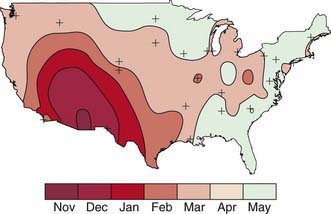Chapter 257 Rotaviruses, Caliciviruses, and Astroviruses
Etiology
Rotavirus, astrovirus, caliciviruses such as the Norwalk agent, and enteric adenovirus are the medically important pathogens of human viral gastroenteritis (Chapter 332).
Enteric adenoviruses are a common cause of viral gastroenteritis in infants and children. Although many adenovirus serotypes exist and are found in human stool, especially during and after typical upper respiratory tract infections (Chapter 254), only serotypes 40 and 41 cause gastroenteritis. These strains are very difficult to grow in tissue culture. The virus consists of an 80-nm-diameter icosahedral particle with a relatively complex double-stranded DNA genome.
Epidemiology
Rotavirus infection is most common in winter months in temperate climates. In the USA, the annual winter peak spreads from west to east (Fig. 257-1). Unlike the spread of other winter viruses, such as influenza, this wave of increased incidence is not due to a single prevalent strain or serotype. Typically, several serotypes predominate in a given community for 1 or 2 seasons, while nearby locations may harbor unrelated strains. Disease tends to be most severe in patients 3-24 mo of age, although 25% of the cases of severe disease occur in children >2 yr of age, with serologic evidence of infection developing in virtually all children by 4-5 yr of age. Infants younger than 3 mo are relatively protected by transplacental antibody and possibly breast-feeding. Infections in neonates and in adults in close contact with infected children are generally asymptomatic. Some rotavirus strains have stably colonized newborn nurseries for years, infecting virtually all newborns without causing any overt illness.








